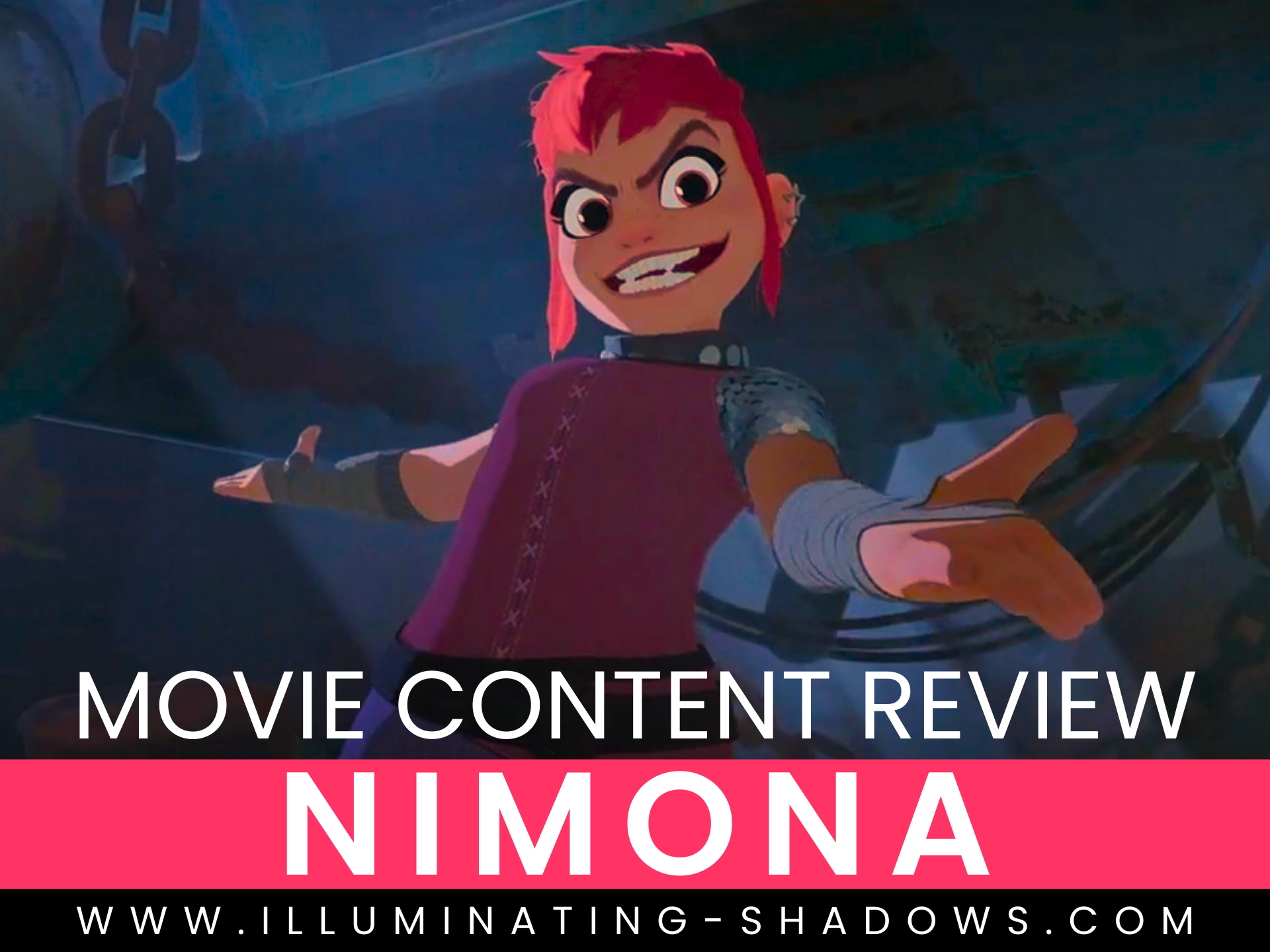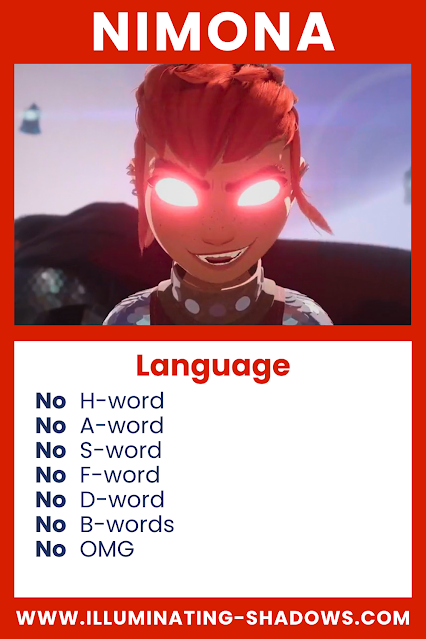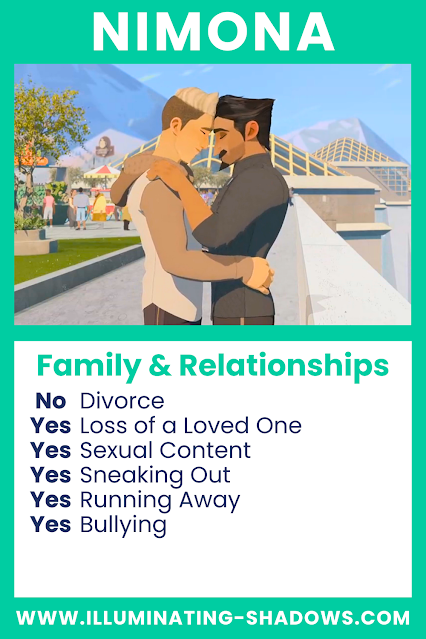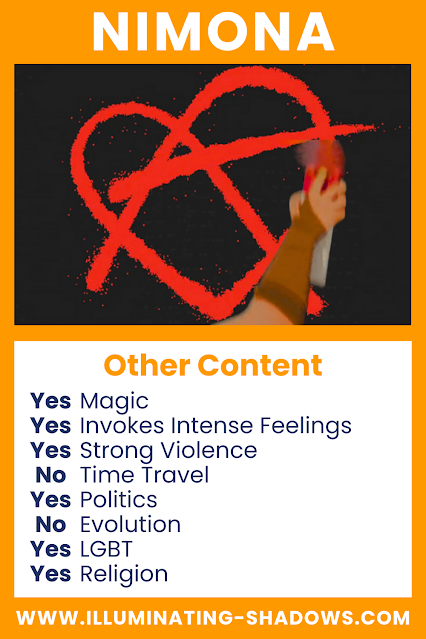During Ballister's knighting ceremony he is framed for assassinating the queen. While hiding from the police he’s befriended by a revenge fueled and murder obsessed shapeshifter named Nimona. Together they seek to clear Ballister’s name and rid the government of corruption.
This content review will contain spoilers when they are relevant.
This page contains affiliate links that earn me a small commission. They don't cost you anything. Their presence/absence doesn't effect the quality of this Content Review. Please see the Disclosures Page to learn more.
Message
This movie was clearly made to push an LGBT message, but it also has anarchist elements.
The viewer quickly learns Ballister is in a gay relationship with Ambrosius, but that relationship is thrown into chaos when Ballister’s sword magically kills the queen and Ambrosius instinctively cuts off Ballister’s arm. Despite being on opposing sides, throughout the movie their love for each other constantly draws them towards one another. Additionally, at the end of the movie they kiss.
Nimona herself seems to be a representation of transgenderism. On numerous occasions Ballister asks her what she is, and she replies “I’m Nimona”. When asked to be herself or not weird, she makes it clear that she has no default form. At one point she shape shifts into a little boy and Ballister says “…and now you’re a boy” to which Nimona responds “I am today”.
The bad guy in the movie, the Director, is in control of the government after the queen dies. She demands a religious like devotion to tradition, and it’s later revealed that the tradition is based on a lie. Meanwhile Nimona is a main character who desires to murder everyone who subscribes to that tradition, because tradition dictates shape shifters are monsters. Together Nimona and Ballister bring down the Director, although with a lot less murder than Nimona originally envisioned. Nimona also takes every opportunity to cause chaos and destroy property.
By the end of the movie citizens have learned to reject their traditions and to accept everyone just as they are. Additionally, the credits show Nimona creating a heart with the LGBTQ+ flag colors and spray painting a variation of the anarchists symbol.
Content
Language
There’s no swearing in this movie, but the movie ends with a cut off “holy shhhh” phrase
Fears
There’s several scenes with fire as part of general mayhem and destruction, and in one instance an accidental fire destroys an entire town.
The Director is a mildly strong villain. She presents herself like a queen, but her actions are deceptive and manipulative. This makes her a constant threat to Ballister and Nimona.
A large chunk of the movie is dark and there’s a couple darker scenes where scary things happen, but the darkness itself isn’t presented as scary.
Nimona herself can be quite scary and creepy. On several occasions she shapeshifts into a little boy that clearly takes inspiration from demon possessed and ghost children in horror movies. On another occasion she’s a massive black smoke beast laying waste to the city. Nimona is also obsessed with murder; she references it often and is constantly trying to get Ballister to murder people. Several of her hand drawn pictures depicting stick figures being murdered are also shown. She attempts suicide once and makes countless creepy/scary remarks and faces throughout the movie. At times Nimona can be a very funny character to an adult that enjoys dark humor, but children will likely find her deeply disturbing.
A character is kidnapped and thrown into the truck of a car. Ballister is jailed, but then Nimona breaks him out of jail. Ballister and Nimona break into the Director's office and surprise her.
There’s no storms or clowns.
Family & Relationships
Later in the movie it's revealed that Nimona is over 1,000 years old and her first friendship was destroyed by townspeople who were afraid of her shape shifting abilities. In the chaos a fire broke out and killed everyone in the town, including her friend’s parents, and her friend hated her so much that she established an entire line of tradition around hating shape shifters. Homosexual lovers Ballister and Ambrosius are torn apart when they are thrust on opposing sides, and the movie depicts both grieving on several different occasions. When Nimona is presumed to be dead, the entire city greives her loss and erects a memorial.
Ballister and Ambrosius kiss. After crashing into a bathroom with a naked man shown from the waist up, Nimona looks down and asks the man if it’s “cold in here”, at which point he thrusts his hands down to cover his off-screen crotch.
While Nimona is sleeping, Ballister sneaks out to have a secret meeting. Nimona runs away after she has a fight with Ballister.
There’s no divorce.
Other Content
In addition to Nimona's shape shifting abilities, this movie also has magical futuristic elements like energy weapons and hover cars.
While there's no time travel to confuse children, there are several flash backs, including a false one that Nimona tells as a joke.
This movie was clearly made to push an LGBT message; you can read more about that in the messages section above.
This is a violent movie, but not in the usual sense; the numerous fighting scenes simply end with characters getting knocked out rather than killed. Instead, the unusual violence is things like Nimona calling for murder at every opportunity and even drawing murderous stick figure pictures, which is disturbing for a children's movie. Additionally there's a long drawn out scene where Nimona attempts suicide because no one likes her, which is not a thought that should be put into children's heads. In another scene a character is stabbed through the stomach and flails around during a violent death, but then the viewer learns it was just Nimona pretending to be the character and she is unharmed. While the exact moment isn't specifically shown on screen, Ballister's arm is cut off by Ambrosius, a fact that is discussed on several occasions.
As mentioned in the messages section above, this movie has an anarchist message. The Director (the bad guy in the movie) seems to represent a political figure, a religious figure, and tradition. The knights follow her like a religious cult, the people follow her traditions like a religion, and the people obey her as a political leader.
The movie does a good job at invoking feelings when it wants to. There's a lot of excitement and anticipation when Ballister and Nimona are running away and fighting, which is really heightened by the choice of catchy music for these scenes. In contrast, there's also several scenes that elicit strong feelings of sadness.
Originally forcing herself onto Ballister as a sidekick, Nimona and Ballister form a friendship with sprinklings of a father-daughter relationship, yet she calls him "boss". "Boss" is an odd term for the type of relationship they have and it feels like the writers intended it to represent something, but I don't know what.
There's no evolution.
Conclusion
Nimona is a dark movie with LGBT and anarchist messages. While it advertises itself as a fun and cool movie for children, the movie's content suggests otherwise.







No comments
Post a Comment